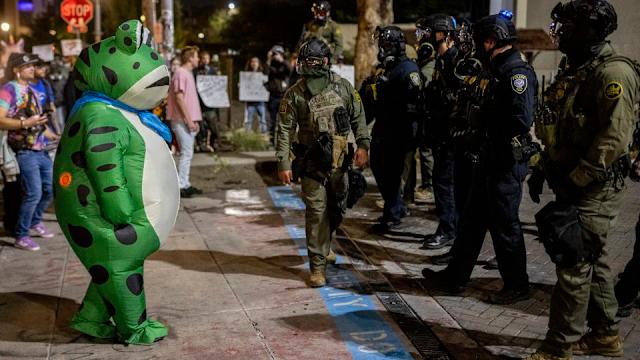It sways in the brisk wind, flies high above all and stands for everything the United States has been built upon and sacrificed to become the strong nation it is today.
The colors of red, white and blue tell the story of valor, purity and perseverance; valor represented by the courageous and heroic actions of the United States armed forces. But what does it really take to build life-sacrificing courage, meet a heroic standard, raise your right hand to swear to defend the people of a nation so great and to face the fear of only fear itself?
It all begins with an unknown destination, on a white bus, face down in a green duffle bag, filled with your new wardrobe for the next 10 weeks.
Alongside you is another soul afraid of the near future. A highly dedicated, motivated, extremely disciplined, physically and mentally tough soldier is walking the aisle yelling commands. This soldier represents many others with an erect posture, broad shoulders and a green hat like no other. This soldier will be your mentor the next 10 weeks, push you past your limits, challenge you beyond capability and make you into what the United States Army stands strong as. This soldier is known as a drill sergeant.
Upon reaching your unknown destination, only hollow barks from soulless beasts and the hopeless echo of boots striking the lifeless dirt of South Carolina can be heard. Running, confused and mentally exhausted already, you find yourself amid chaos and crowded shoulder to shoulder in what is supposed to be a formation.
Immediately the soulless beasts demonstrate the proper push up and you begin to go through your first smoke session.
After dumping out and repacking your bags several times, you’re given one minute to make your last phone call to whomever you choose. With a drill sergeant in your face and your loved one on the other side, you will most likely have trouble holding back the tears and will be forced to “push” (do push-ups) after completing your phone call.
After the long day of going over restrictions and regulations, pushing until muscle failure, enduring yelling in your face and countless amounts of running it is time to go to what you think is sleep. Following getting squared away for the evening, you’d lay in your bed to only look upon the ceiling of the barracks or the bottom of the bunk on top of you thinking only nine weeks, two days and a wake-up left.
In short time, you and the rest of your battle buddies adapt to the nature of the Army and the life of a basic training soldier. Soon enough you’ll meet your three-week mark, “graduate” from red phase into white phase, and begin to realize that if you carry out all directions given to you, fall into formation on time and are in proper uniform, the next six weeks won’t be so bad.
During red phase – which consists of the first three weeks of basic training – soldiers become familiar with customs and courtesies of the military, military bearing, what it takes to be a soldier of discipline and what soldiers need to do to become physically and mentally stronger.
Drill sergeants are on top of their game during this phase and will look for anything to enforce corrective training, because in the long run it makes for stronger, determined and highly disciplined soldiers.
Also during red phase soldiers are required to go through the gas chamber, one of the most hated and dreaded requirements at basic training. Most will never forget the feeling they experience when being exposed to the CS gas or tear gas; it becomes a feeling that cannot even be described, unless you’ve been exposed to it before.
Following red phase is white phase. When transitioning into this phase, soldiers begin to gain their first “freedoms,” given that they continue to meet the expectations of their drill sergeants, but may be thrust back into red phase based on the assessment of the company commander and first sergeant.
Soldiers are given the privilege to ride the bus to church, away from the training area, and are given more personal time at the end of the training day.
White phase consists of long days at the shooting range and loads of concurrent training. Over the course of Basic Rifle Marksmanship (BRM), the company commander drills the importance of qualifying with M-16 rifles into the soldiers.
This gives way to lots of concurrent training – practicing different shooting stances for long periods of time, over and over again to reinforce steady positions. All soldiers are required to shoot at least 23 out of 40 pop up targets at different distances.
When soldiers reach the last three weeks of their training, they experience the transition into blue phase.
During this phase soldiers are on their way to showing that they are well trained, disciplined soldiers. Soldiers experience the “earned features” of basic training in this phase: getting the chance to shoot heavy weapons such as the M-249 Saw and M-240 Bravo, both high-powered machine guns; the rocket launcher and the M-240 grenade launcher. They are also given the chance to throw two live hand grenades once qualifying.
During the last week of blue phase and the week before graduating, the battalion is sent out in the middle of nowhere to a mock base set up as a forward operating base (FOB) in Afghanistan. While there the battalion completes different training exercises such as mock day and night missions, gate-guarding, ambushing different companies and pulling security.
By this time the drill sergeants observe and allow soldiers to make decisions for themselves and their platoons, giving them a chance to make mistakes and fix them themselves.
After completing this five-day, four-night field training exercise, soldiers complete a 10-mile foot march back to their company area: the last requirement before graduating four days later.
In between the time of the final 10-mile foot march and graduation, a soldier’s day consists of spotless cleaning, final paperwork and embracing the soldier and person they have become following their dedicated and determined journey through the nine weeks and three days of basic training.
Although it is challenging, soldiers realize that the endless hours of fire guard (staying up for an hour every three nights to guard weapons and watch the barracks), physically demanding mornings of physical training, mental exhaustion of carrying out tasks, constant smoke sessions of the first couple of weeks, never-ending road marches behind the lead of the company commander, the countless hours of cleaning your M-16 and the numerous times of repeating, “Yes, drill sergeant!” were all more than worth it.
Drill sergeants have transitioned in your mind from soulless beasts to mentors whom you will remember the rest of your military career and life, for influencing the soldier you will stand tall as in the years to come.
Although basic training stands as only the first part of a soldier’s military career, it gives them the calling to say “I am an American soldier” for the first time as they embark on the rest of their military careers. The United States can raise the colors every day, knowing that soldiers are becoming battle-ready across the country at every hour.
The United States was built upon the heroes of the United States military, but before becoming heroes, all soldiers must start somewhere. That somewhere is Basic Combat Training.







